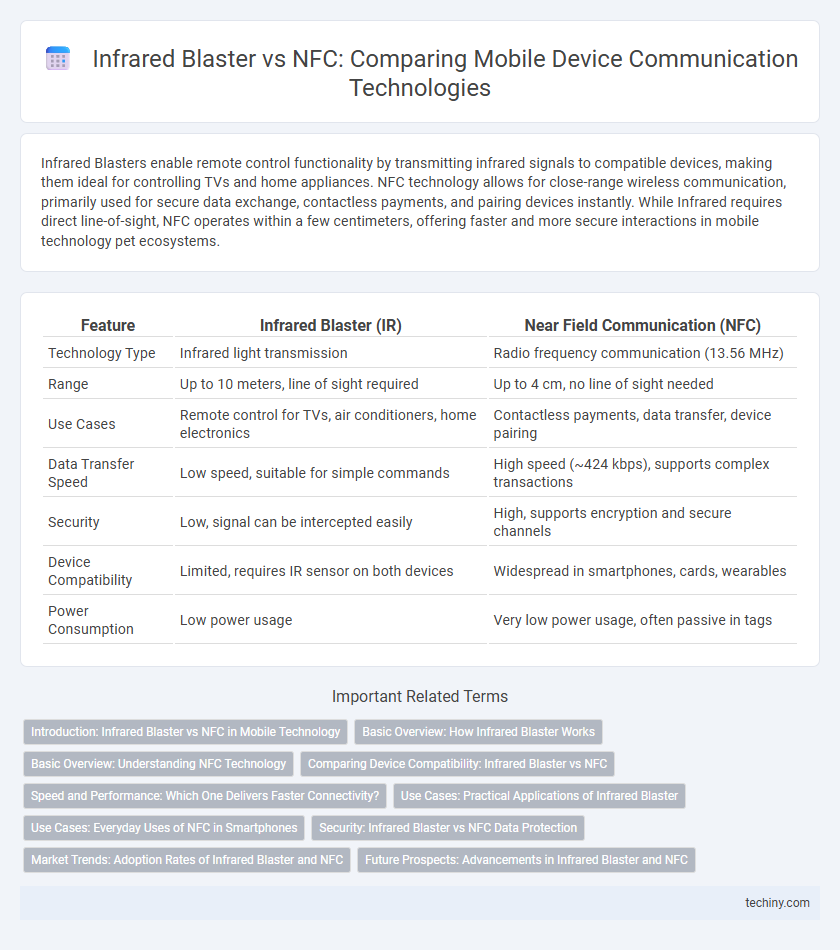Infrared Blasters enable remote control functionality by transmitting infrared signals to compatible devices, making them ideal for controlling TVs and home appliances. NFC technology allows for close-range wireless communication, primarily used for secure data exchange, contactless payments, and pairing devices instantly. While Infrared requires direct line-of-sight, NFC operates within a few centimeters, offering faster and more secure interactions in mobile technology pet ecosystems.
Table of Comparison
| Feature | Infrared Blaster (IR) | Near Field Communication (NFC) |
|---|---|---|
| Technology Type | Infrared light transmission | Radio frequency communication (13.56 MHz) |
| Range | Up to 10 meters, line of sight required | Up to 4 cm, no line of sight needed |
| Use Cases | Remote control for TVs, air conditioners, home electronics | Contactless payments, data transfer, device pairing |
| Data Transfer Speed | Low speed, suitable for simple commands | High speed (~424 kbps), supports complex transactions |
| Security | Low, signal can be intercepted easily | High, supports encryption and secure channels |
| Device Compatibility | Limited, requires IR sensor on both devices | Widespread in smartphones, cards, wearables |
| Power Consumption | Low power usage | Very low power usage, often passive in tags |
Introduction: Infrared Blaster vs NFC in Mobile Technology
Infrared Blaster (IR Blaster) enables mobile devices to control home electronics by emitting infrared signals, mimicking traditional remote controls. Near Field Communication (NFC) facilitates contactless data exchange and secure transactions within a short range, enhancing mobile payments and device pairing. Both technologies serve distinct purposes in mobile technology, with IR Blaster focused on remote control functionality and NFC on wireless communication and authentication.
Basic Overview: How Infrared Blaster Works
Infrared Blaster (IR Blaster) transmits signals using infrared light waves, similar to a TV remote, allowing devices to control appliances such as TVs, air conditioners, and set-top boxes. Unlike NFC, which relies on short-range radio frequency communication for data exchange, IR Blaster requires a direct line of sight to the target device and works by emitting encoded infrared signals. This technology is widely used in mobile devices to provide universal remote control functionality without the need for physical connections or pairing protocols.
Basic Overview: Understanding NFC Technology
Near Field Communication (NFC) technology enables short-range wireless communication between compatible devices, typically within 4 centimeters, allowing for quick data exchange and contactless transactions. Unlike Infrared Blasters that require a direct line-of-sight to control devices, NFC operates through electromagnetic fields, facilitating seamless device pairing and secure information transfer. NFC's integration in mobile technology enhances functionalities such as mobile payments, access control, and data sharing without physical contact or alignment constraints.
Comparing Device Compatibility: Infrared Blaster vs NFC
Infrared Blasters are compatible with a wide range of older and modern devices that use IR signals, such as TVs, air conditioners, and home appliances, allowing control without direct connectivity or internet access. NFC technology requires devices to have built-in NFC chips, commonly found in modern smartphones, smartwatches, and payment terminals, enabling secure data exchange at close range. While Infrared Blasters excel in remote control functionality across various brands, NFC offers seamless peer-to-peer communication and contactless transactions limited to devices within short distances.
Speed and Performance: Which One Delivers Faster Connectivity?
Infrared blasters operate by transmitting signals via infrared light, offering limited range and slower data transfer speeds compared to NFC technology, which uses radio frequency for near-field communication with faster connection times and higher data transfer rates. NFC supports instantaneous pairing and secure data exchange within a few centimeters, making it ideal for quick, seamless transactions and device interactions. Infrared technology, while useful for remote controls, cannot match the rapid connectivity performance and versatility provided by NFC in mobile devices.
Use Cases: Practical Applications of Infrared Blaster
Infrared blasters enable remote control functionality for home appliances like TVs, air conditioners, and set-top boxes, making smartphones universal remotes without requiring internet connectivity. This technology excels in environments where network-based controls fail, offering reliable line-of-sight communication for seamless device operation. Infrared blasters are particularly useful in smart home setups prioritizing simplicity and compatibility with legacy electronic devices.
Use Cases: Everyday Uses of NFC in Smartphones
NFC technology in smartphones enables seamless contactless payments, quick pairing with Bluetooth devices, and convenient access to public transportation systems. Infrared blasters primarily control home electronics like TVs and air conditioners, limiting their everyday utility compared to NFC's versatile applications. The widespread adoption of NFC facilitates secure data transfer and digital identification, enhancing daily interactions and mobile convenience.
Security: Infrared Blaster vs NFC Data Protection
Infrared Blasters transmit data via line-of-sight infrared light, making them less susceptible to remote hacking but vulnerable to interception by nearby eavesdroppers. NFC (Near Field Communication) utilizes short-range radio waves with built-in encryption and secure element technology, offering enhanced data protection through contact proximity and cryptographic protocols. This intrinsic security framework in NFC significantly reduces risks of data theft and unauthorized access compared to the unencrypted infrared signals of Infrared Blasters.
Market Trends: Adoption Rates of Infrared Blaster and NFC
Infrared Blaster technology, once popular in smartphones for remote control functions, has seen a significant decline in adoption rates due to the rise of wireless alternatives. Near Field Communication (NFC) has experienced rapid growth, driven by its widespread use in contactless payments, access control, and data exchange. Market trends indicate NFC adoption surpassing 60% in new smartphone models globally, while infrared blasters are now present in less than 10% of devices.
Future Prospects: Advancements in Infrared Blaster and NFC
Infrared Blaster technology is evolving with enhanced range and precision, enabling more robust device interoperability and smart home integration. Near Field Communication (NFC) advancements focus on higher data transfer speeds, improved security protocols, and expanded applications in contactless payments and identity verification. Future prospects indicate a complementary coexistence where Infrared excels in line-of-sight control and NFC dominates close-proximity secure transactions.
Infrared Blaster vs NFC Infographic

 techiny.com
techiny.com